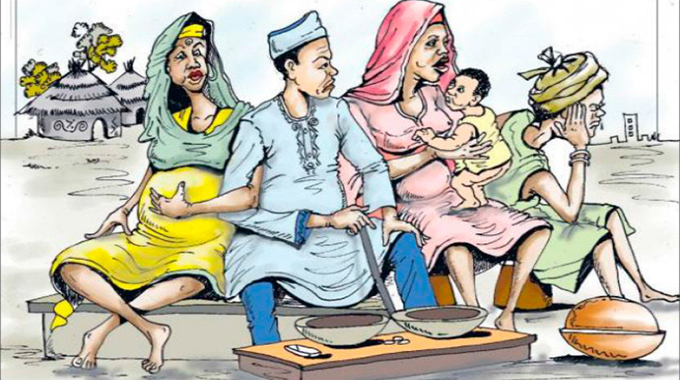Religion: An African’s dilemma
When a dim-sighted traveller first arrives in the land of milk, honey and dust or Guruve and is confronted with kilometre after kilometre of apparently empty bush, scattered mud-and-pole huts surrounding one European-style main house, a main tarred road, several gravel paths and precious little-else, life seems empty.
Among many other absences the most striking one, is the absence of a record of the past. A record of the history, the religious history and the only thing that quickly strikes you are the ghostly figures of the spirit mediums, the autochthons of the land, the rain and the people.
Not interested in boarding cars and buses, unless it is really necessary, the mediums are dressed in long black cloths draped across the right shoulder and reaching to the feet. A light and eared ritual axe, a walking stick and a tobacco pouch, are the insignia of the genuine spirit medium. A reed sun hat completes the figures. They are never frivolous and mean! The welfare of their descendants is their prime concern.
Normally, when they meet scantily dressed women or anyone dressed in red, they look aside, for those ills visually assaults them. Red conjures memories of blood. Talk of Nehanda, Mutota, Chidyamauyu, Nyamapfeni, Gumboremvura, Dumburechuma, Chingowo, Tsenge, Chitehwe, Karitundundu and Chirambakudomwa, Svembere and others.
In the traditional spiritual province or realm, all women and men are expected to provide for and protect their families as best as they can. Even when they die and leave their bodies to be planted in the graves they do not cease to care for their descendants since the richness in their knowledge, personalities and depth of their experience do not come to an abrupt end and dissipate for all time.
They are immediately transformed into ancestors, who know the future before it happens and can cure the ill. They make the perfect parents since in the village human life is greatly enhanced by its own end. The soothsayers! In the village, ancestors have no material form and so can be in all the places at the same time, they can see and hear and have desires and emotions, even.
Although the ancestors are unceasingly generous, and concerned only with the welfare of the living, their protection is not automatic, it must be won, be performing certain rituals in a much as most Christians ritualise going to church as a way of appealing to the almighty.
On the other hand Evangelicals are aggressively opposed to what they see as backwardness that results from traditional religion and kinship. Their members may have only one wife, they might not drink beer and ancestral spirits are characterised as Satan’s tools, seeking to deceive and bind believers to their old heathen ways. So members of the church do not normally participate in traditional rituals where they are known, yet in their villages they do participate. Who is cheating who? There are dotted Christian churches in the villages and to many Africans striking the balance between tradition and Christianity ends up with Churchianity, (going to church for other reasons that are not necessarily Christian.)
In the villages, the distinction between religion and religiosity — the art and the belief — often manifests itself clearly at funerals where Christianity, Churchianity and African tradition take their ritual roles systematically, but differently.
It is fact, not fiction that many Zimbabweans are Christians by day and African traditionalists by night, many Zimbabweans are Christians in town and traditionalists in their rural homes and at the end this villager asks, who is fooling who or what is blending what and what brand are we? Doubled edged swords!
Very few, if any Zimbabweans, adhere 100 percent to Christianity and the opposite is true. Almost every Zimbabwean at one stage or the other consults faith healers, traditional healers, spirit medium and of late, tele-evangelists. We do everything.
Even our funerals are a cocktail or buffet of rituals. At one stage traditional rituals take precedence and almost immediately Christian ritual take place and vice versa until the body in planted into the soil, forever.
Recently, this villager was an officiant, being the eldest son of the eldest daughter of my deceased grandmother, at a funeral in the Nyakapupu Small Scale commercial farming area, ordinarily referred to as the African purchase area. So it helps. The main officiant of the burial was the family friend (sahwira), a non-kinsman, whose relationship was inherited patrilineally forming reciprocating lineages of ritual friends and has remained trusted.
The religious officiant was a catholic catechist.
Being the coming of the dry season, and a late afternoon, the sub burnt out of a massive cloudless sky. At catholic women came in bunches talking and going up to the beginning of the perimeter fence and, there, one would say to the others. “Hey we have arrived, who starts? Who starts the wailing? You start . . . No, you start . . . Okay let me start!” And, of they went, like dynamite the group would explode into a frenzy of wailing, increasing in tempo and crescendo. That is church women for you! The church led the mourning the traditionalists led the burial and this villager co-ordinated the processes.
When the grave had been dug, a shelf was hallowed out of the base. But since mother was catholic, the funeral wake did not go around her kitchen as is the traditional norm, the Christian dust-to-dust process was done. The Christians ended there and handed over the ritual to the burial officiant. It was time for the traditional beliefs. The body was placed on the shelf, and sealed off with a reed mat and wooden poles.
The grave was then filled with stones and soil, on top of which were even much heavier stones and a mound of soil. The precautions were taken to make it difficult for witches to get at the body. What was very striking was that since the dust-to-dust process no member of the ancestral lineage of the deceased participated in the real planting of the body, neither did they carry the body.
The final party of the burial was sweeping of the grave and the surrounding area so that if witches visit, their footprints will be seen. This was performed by the deceased’s daughters-in-law, the wives of her sons or classificatory sons. In the village no one has no sons or daughters, there are always classificatory ones for you.
First thing in the morning after burial, the burial officiant and the funeral officiant led the procession of the close relatives to check if the grave has not been tampered with by the witches.
The point is which a Zimbabwean is 100 percent Christian and which Christian does not dabble in traditional ritual when he or she visits the village. Now that we are all villagers, belonging to chief so and so who is totally Christian? Who does not practice churchianity by going to the church to show off new clothes, a new car and by going to church to look for girlfriend or boyfriends? How many of us go to church for the sake of going there?
The village soothsayer, the ageless autochthon of knowledge and wisdom says many Zimbabweans confuse themselves by mixing rituals and becoming victims of churchianity. I rest my case for now.







Comments